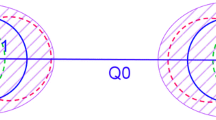Abstract
Results of the Hartree–Fock–Wigner correla- tion model for diatomic molecules with light atoms (H2, LiH, Li2, F2, He2, Ne2) using two different atomic parametrizations and one molecular parametrization of the correlation kernel are presented and interpreted in terms of Wigner intracules as well as differences thereof. The molecular parametrization yields encouraging results for simple systems exhibiting covalent or ionic bonding. However, similar to the purely atomic parametrizations severe overestimations of the attractive interaction in van der Waals systems is observed. It is argued that the remaining shortcommings partly result from the restriction of the currently used correlation kernel to be symmetric in relative position and relative momentum.
Similar content being viewed by others
References
Schleyer PvR, Allinger NL, Clark T, Gasteiger J, Kollman PA, Schaefer III HF, Schreiner P.R. (eds) (1998). Encyclopedia of computational chemistry. Wiley, Chichester
Szabo A, Ostlund N (1989) Modern quantum chemistry: Introduction to advanced electronic structure theory dover
Parr RG and Yang W (1989). Density-functional theory of atoms and molecules. Oxford, New York
Kohn W, Becke AD and Parr RG (1996). J Phys Chem 100: 12974
Stollhoff G and Fulde P (1980). J Chem Phys 73: 4548
Stoll H (1992). Phys Rev B 46: 6700
Shukla A, Dolg M, Fulde P and Stoll H (1999). Phys Rev B 60: 5211
Pisani C, Pusso M, Capecchi G, Casassa S, Dovesi R, Maschio L, Zicovich-Wilson C and Schütz M (2005). J Chem Phys 122: 094113
Gill PMW, Crittenden DL, O’Neill DP and Besley NA (2006). Phys Chem Chem Phys 8: 15
Gill PMW, O’Neill DP and Besley NA (2003). Theor Chem Acc 109: 241
Wigner W (1932). Phys Rev 40: 749
Besley NA, O’Neill DP and Gill PMW (2003). J Chem Phys 118: 2033
Besley NA and Gill PMW (2004). J Chem Phys 120: 7290
Gill PMW, Besley NA and O’Neill DP (2004). Int J Quant Chem 100: 166
Gill PMW and O’Neill DP (2005). J Chem Phys 122: 094110
Fondermann R, Hanrath M, Dolg M and O’Neill DP (2005). Chem Phys Lett 413: 237
Rassolov VA (1999). J Chem Phys 110: 3672
Preuss H (1955). Z Naturforsch A 10: 267
Whitten JL (1963). J Chem Phys 39: 349
Staemmler V Integral and Hartree–Fock modules of the Bochum suite of ab initio programs
Driesler F and Ahlrichs R (1973). Chem Phys Lett 23: 571
Ahlrichs R (1974). Theor Chim Acta 33: 157
Lee C, Yang W and Parr RG (1988). Phys Rev B 37: 785
Miehlich B, Savin A, Stoll H and Preuss H (1989). Chem Phys Lett 157: 200
Wilson AK, Mourik Tv and Dunning TH (1997). J Mol Struct (THEOCHEM) 388: 339
Feller D unpublished set for Li
O’Neill DP and Gill PMW (2006). Recent advances in electron correlation methodology. Oxford, New York
Ahlrichs R and Kutzelnigg W (1968). J Chem Phys 48: 1819
van Mourik T, Wilson AK and Dunning TH Jr (1999). Mol Phys 96: 529
Aziz RA, Janzen AR and Moldover MR (1995). Phys Rev Lett 74: 1586
Aziz RA and Slaman MJ (1989). Chem Phys 130: 187
Huber KP and Herzberg G (1979). Molecular spectra and molecular structure, IV, constants of diatomic molecules. Van Nostrand Reinhold, New York
Lie GC and Clementi E (1974). The J of Chem Phys 60: 1275
Lie GC and Clementi E (1974). The J of Chem Phys 60: 1288
Author information
Authors and Affiliations
Corresponding author
Rights and permissions
About this article
Cite this article
Fondermann, R., Hanrath, M. & Dolg, M. The performance of the Hartree–Fock–Wigner correlation model for light diatomic molecules. Theor Chem Account 118, 777–783 (2007). https://doi.org/10.1007/s00214-007-0360-0
Received:
Accepted:
Published:
Issue Date:
DOI: https://doi.org/10.1007/s00214-007-0360-0




